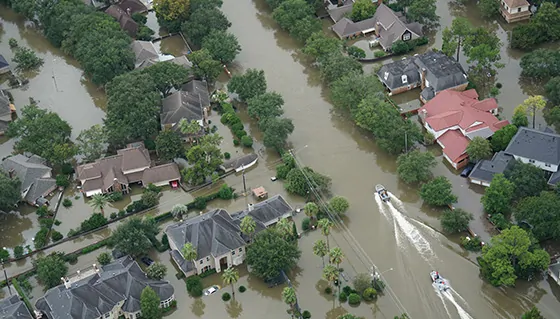Your Genesys Blog Subscription has been confirmed!
Please add genesys@email.genesys.com to your safe sender list to ensure you receive the weekly blog notifications.
Subscribe to our free newsletter and get blog updates in your inbox
Don't Show This Again.

Like most of the nation, I’ve spent the past few days in shock, watching news updates from afar on the unspeakable devastation wrought by Hurricane Harvey along the Gulf coast. The hours pass with new images and reports accumulating to convey the disastrous enormity of the storm and the rough road to recovery that doubtless lies ahead. As the rain continues to fall and flooding spreads, I’m struck by how powerless we seem in the face of nature’s fury. But I’m also heartened by the heroism and ingenuity displayed by those stranded in the storm’s wake and the valiant men and women laboring tirelessly to aid them. My colleagues at Genesys have also been watching the events unfold – and their enthusiasm to help was immediate and heartwarming.
Since my area of expertise is communications technology, I’ve been naturally attuned to stories about the ways people are sharing information, calling for assistance, coordinating rescue and relief efforts, and adapting to overcome obstacles to human contact — no power, rising water, impassable roadways, 911 overwhelmed, drenched cell phones with dying batteries … In a catastrophe of this magnitude, our channels for communication are also under assault and even our most reliable standbys can fail us.
On Sunday, CNN reported that Houston 911 was struggling to scale to meet the volume of calls — 56,000 during a time period that would normally see 8,000. The storm also took out a dozen emergency call centers, and it was difficult for those in need to reach those who could help. Many turned to Facebook and Twitter to summon aid.
The Coast Guard urged people to continue using traditional emergency phone contact to reach out, but it did so on Twitter. In fact, social media channels have taken on a significant role in relief and rescue communications during this crisis. There are reports that emergency responders “sent out pleas on social media to residents who own boats and high-water vehicles, asking them to contact fire officials to help with rescues in flooded neighborhoods.” And reports of citizen rescue groups, such as the Cajun Navy using “Facebook and Twitter to relay rescue information.” Social channels are proving to be crucial to our emergency communications infrastructure.
While that might seem obvious in light of how integral social media has become in other aspects of our lives, it is actually pretty amazing. Recall that when Hurricane Katrina swamped New Orleans, Twitter didn’t yet exist and Facebook was less than a year old. These entirely new channels of communication have already become second nature to us.
We’re an adaptive species. Whatever the circumstance, human beings always come up with new and more and better ways to communicate. Alone, none of our communication channels are perfect or fail-safe. But we keep refining and reimagining and inventing and integrating. When one fails, we can move to the next, and so on, until our message gets through. Until we make contact.
It remains for us in the communications technology space to continue to feed that spirit of ingenuity — doggedly innovating, championing the adoption of new communications channels, and integrating every one that emerges into our systems of contact. This is what we do at Genesys, and we are proud that our technology is supporting government agencies behind the scenes.
While it’s far too soon for Monday-morning quarterbacking, one astute reporter proposed that “in coming months, Harvey should be a case study that helps relief agencies, first responders, and tech companies work together to streamline rescue efforts with available technology.” Scalable, integrated, omnichannel communications solutions will play a huge part in that future effort.
In the here and now, my thoughts are with those weathering this storm. Luckily, while a few of our own employees have been affected, they are safe. Genesys has set up a matching program for employees to help with the overall relief efforts in Texas and will donate to the Hurricane Harvey Relief Fund established by Houston Mayor Sylvester Turner. Resources are here and here on ways to provide assistance though additional charitable organizations.
Subscribe to our free newsletter and get blog updates in your inbox.